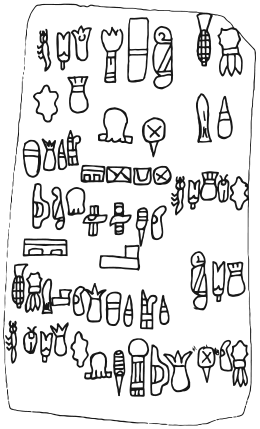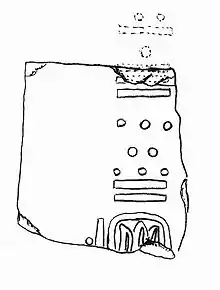Olmec hieroglyphs
Olmec hieroglyphs (alternatively Olmec glyphs, Olmec writing, or Olmec script) designate a possible system of writing or proto-writing developed within the Olmec culture. The Olmecs were the earliest known major Mesoamerican civilization, flourishing during the formative period (1500 BCE to 400 BCE) in the tropical lowlands of the modern-day Mexican states of Veracruz and Tabasco.[1] The subsequent Epi-Olmec culture (300 BCE to 250 CE), was a successor culture to the Olmec and featured a full-fledged writing system, the Isthmian (or Epi-Olmec) script.
The existence of a writing system in Middle and Late Olmec periods has been a matter of long-standing debate. Direct evidence includes the appearance of individual (potential) glyphs as well as the singleton Cascajal Block that bears a potential text. Indirect evidence includes similarities in calendar and writing systems between subsequent Mesoamerican cultures, for which the Olmecs are sometimes considered a mother culture.[2]
Periodization
Cascajal block (approx. 900 BCE)

In September 2006, a report published in Science magazine announced the discovery of the Cascajal block, a writing-tablet-sized block of serpentine with 62 characters unlike any yet seen in Mesoamerica. This block was discovered by locals in the Olmec heartland and was dated by the archaeologists to approximately 900 BBC based on other debris. If the authenticity and date can be verified, this will prove to be the earliest writing yet found in Mesoamerica. The symbols on the Cascajal block are unlike those of any other writing system in Mesoamerica, such as in Mayan languages or Isthmian, another extinct Mesoamerican script. The Cascajal block is also unusual because the symbols apparently run in horizontal rows and "there is no strong evidence of overall organization. The sequences appear to be conceived as independent units of information".[3] The 28 unique Cascajal block characters bear no obvious resemblance to later glyphs. If indeed, it has been a script, "[the Cascajal block script] apparently left no descendants, with no certain link to Isthmian or other Formative [period] writing." (Skidmore 2007,p. 5)[4]
Middle Formative toponyms (900–500 BCE)
All Mesoamerican writing systems feature toponyms,[5] i.e. emblems or graphic images, which join distinct elements into meaningful arrangements but do not directly codify any specific set of sounds''.[6] These toponyms seem to have been employed in Olmec-style art since the Middle Formative period (900-500 BCE), but the degree to which they constitute writing (i.e., record spoken language) is debated.[7][8] Possible toponyms include two examples from Guerrero,[9][10] a possible place sign come from Oxtotitlán Cave, Guerrero,[6] an incised greenstone celt from unknown provinience and a tablet from Ahuelican.[11]
Potential glyphs (650–400 BCE)
It was long thought that many of the glyphs present on Olmec monumental sculpture represented an early Olmec script. `If writing is (1) a graphic representation of language, (2) detached from the body of its referent, and (3) disposed into linear sequences that can theoretically expand into greater degrees of syntactic complexity, then writing first appears in Mesoamerica in the century between 600 and 500 BC, as attested on La Venta Monument 13',[12] the so-called "Ambassador Monument" (tentatively dated to 650 – 450 BCE,[13] resp. 600-400 BCE,[12] for an image see the Linda Schele photograph collection[14]).
Aside from monumental sculpture, potential glyphs have been found on portable objects such as celts,[15] sherds, etc. However, several glyphs clearly continue symbols previously established in iconography rather than writing[16] (this may include the aforementioned toponyms), so that their use for recording spoken language can only be ascertained if multiple potential glyphs appear in combination.
.svg.png.webp)

In 2002, one such a glyph group was confirmed for two possible glyphs at San Andres:[17] Excavations conducted in 1997 and 1998 produced three artifacts that many archaeologists contend demonstrate that the Olmec civilization used a true writing system. These artifacts, dated roughly to 650 BCE (the middle of the Olmec concentration at La Venta and San Andres), were found in a refuse dump, the remains from a festival or feast. “The fact that the artifacts with glyphs were found in the context of feasting refuse suggest that writing among the Olmec was sacred and was closely tied to ritual activities.” [18] The most important find was a fist-sized ceramic cylinder seal, likely used to print cloth. When rolled out, the seal shows two speech scrolls emanating from a bird, followed directly by a number of design elements enframing what has been interpreted as logograms for “king (sideways U shape),” "3 (three dots, according to the Mesoamerican bar and dots numbering system),” and “Ajaw (from the sacred 260-day calendar)", a designation used for both a calendar date and, in keeping with Mesoamerican custom, the name of an Olmec ruler. In addition to the ceramic cylinder seal, two fingernail-sized fragments from a greenstone plaque have been recovered, each containing an incised glyph. Both these glyphs have been linked to well-documented glyphs in other Mesoamerican writing systems, including the Isthmian (Epi-Olmec) and Maya scripts.[19]
Well-known archaeologist and writer Michael D. Coe interprets the San Andres glyphs as "an early kind of writing" [20] while Richard A. Diehl, who excavated at the Olmec site of San Lorenzo Tenochtitlan with Coe, finds that this discovery "establishes the existence of Olmec writing and calendrics by 650 B.C.E" [21] On the other hand, Mayanist epigrapher David Stuart stated that it would be hard to discern evidence of a writing system in a handful of symbols.[20] The question was complicated in 2006 by the discovery of the Cascajal Block. The 28 unique Cascajal block characters bear no obvious resemblance to the San Andres glyphs and are, indeed, unlike those of any other Mesoamerican writing system.[4] Questions concerning the interpretation of the San Andrés glyphs (and the Cascajal block) will need to await further research.
A cylinder seal from Tlatilco, dated to a time frame of Olmec occupation, appears to carry a non-pictographic, linear script.[22] A cylinder seal from Chiapa de Corzo, Mexico, also appears to be an example of an unknown Mesoamerican script. Both have been discussed as potential evidence for Olmec writing as they appeared during a time of Olmec influence.[23]
.jpg.webp)
Epi-Olmec or Isthmian script (300 BCE onwards)

A small number of Epi-Olmec artifacts found in the Isthmus of Tehuantepec show examples of an early Mesoamerican writing system which “may itself descend from an Olmec hieroglyphic system, but too little of the Olmec script has been recovered to confirm or disprove a connection” (Justeson and Kaufman 1993:1703).[24]
The longest of these texts are on La Mojarra Stela 1 and the Tuxtla Statuette. The writing system used is very close (and possibly ancestral) to the Maya script, using affixal glyphs and Long Count dates, but is read only in one column at a time as is the Zapotec script. An Epi-Olmec stela from Chiapa de Corzo is the oldest monument of the Americas inscribed with its own date: the Long Count dates it to 36 BCE. A sherd from Chiapa de Corzo dated to 300 BCE was held to be the oldest instance of that writing system yet discovered,[25] but more recently, it has been suggested that early Isthmian writing at Chiapa de Corzo even pre-dates the Epi-Olmec culture.[26]
In a 1997 paper, John Justeson and Terrence Kaufman put forward a decipherment of Epi-Olmec. The following year, however, their interpretation was disputed by Stephen Houston and Michael D. Coe, who unsuccessfully applied Justeson and Kaufman's decipherment system against epi-Olmec script from the back of a hitherto unknown mask. The matter remains under dispute.
References
- Diehl, Richard A. (2004). The Olmecs : America's First Civilization. London: Thames and Hudson. pp. 9–25. ISBN 0-500-28503-9.
- "Esta gran cultura, que encontramos en niveles antiguos, es sin duda madre de otras culturas, como la maya, la teotihuacana, la zapoteca, la de El Tajín, y otras” ("This great culture, which we encounter in ancient levels, is without a doubt mother of other cultures, like the Maya, the Teotihuacana, the Zapotec, that of El Tajin, and others".) Caso (1942), p. 46.
- Rodríguez Martínez, Ma. del Carmen; Ponciano Ortíz Ceballos; Michael D. Coe; Richard A. Diehl; Stephen D. Houston; Karl A. Taube; Alfredo Delgado Calderón (2006-09-16). "Oldest Writing in the New World". Science. Washington, DC: American Association for the Advancement of Science. 313 (5793): 1610–1614. Bibcode:2006Sci...313.1610R. doi:10.1126/science.1131492. OCLC 200349481. PMID 16973873. S2CID 35140904.
- Skidmore, Joel (2006). "The Cascajal Block: The Earliest Precolumbian Writing" (PDF). Mesoweb Reports & News. Mesoweb. Retrieved 2007-06-20.
- Brotherston, G. (1999) ‘Place Signs in Mesoamerican Inscriptions and Codices’, in W. Bray and L. Manzanilla (eds.) The Archaeology of Mesoamerica: Mexican and European Perspectives. London: British Museum Press. 50-67
- Arnaud F. Lambert (2013), A possible place-sign (toponym) from Oxtotitlán Cave, Guerrero, Mexico, The Post Hole (the student-run archaeology journal) 27: 17-28, https://www.theposthole.org/sites/theposthole.org/files/uploads/192/posthole_27_192.pdf
- Pohl, M.E.D., Pope, K.O. and Von Nagy, C. (2002) ‘Olmec Origins of Mesoamerican Writing’. Science. 298. 1984-1987
- Rodríguez Martínez, M.C., Ortíz Ceballos, P., Coe, M.D., Diehl, R.A., Houston, S.D., Taube, K.A. and Calderón, A.D. (2006) Oldest Writing in the New World. Science 313: 1610-1614
- Coe, Michael D; Princeton University; Art Museum; Museum of Fine Arts, Houston (1995). The Olmec world: ritual and rulership. pp. catalogue, plates127 and 131. ISBN 978-0-8109-6311-5. OCLC 34103154.
- Houston, S.D. (2004) ‘Writing in Early Mesoamerica’ in S.D. Houston (ed.) The First Writing: Script Invention as History and Process. 274-309. New York: Cambridge University Press, p. 285, Figures 10.4a and 10.4b
- Arnaud F. Lambert (2013), A possible place-sign (toponym) from Oxtotitlán Cave, Guerrero, Mexico, The Post Hole (the student-run archaeology journal) 27: 17-28, https://www.theposthole.org/sites/theposthole.org/files/uploads/192/posthole_27_192.pdf, Fig. 5.a, 5.b
- Houston, S.D. (2004) ‘Writing in Early Mesoamerica’ in S.D. Houston (ed.) The First Writing: Script Invention as History and Process. 274-309. New York: Cambridge University Press, p. 292
- Rice, Prudence M. (2009-02-17). Maya Calendar Origins: Monuments, Mythistory, and the Materialization of Time. University of Texas Press. p. 96. ISBN 978-0-292-77449-0.
- "Schele Photograph Collection, Schele Number: 127019". research.famsi.org. Retrieved 2020-05-03.
- Stuart, David (2015-01-26). "The Royal Headband: A Pan-Mesoamerican Hieroglyph". Maya Decipherment. Retrieved 2020-04-24.
- F. Kent Reilly, III (1996), The Lazy-S: A Formative Period Iconographic Loan to Maya Hieroglyphic Writing, In Martha J. Macri and Jan McHargue (eds.), Eighth Palenque Round Table, 1993 .
- https://science.sciencemag.org/content/298/5600/1984/tab-figures-data
- Pohl, Mary (2005). "Olmec Civilization at San Andrés, Tabasco, México". Foundation for the Advancement of Mesoamerican Studies, Inc. (FAMSI): 10.
- Pohl, Mary; Kevin O. Pope; Christopher von Nagy (2002). "Olmec Origins of Mesoamerican Writing". Science. 298 (5600): 1984–1985. Bibcode:2002Sci...298.1984P. doi:10.1126/science.1078474. PMID 12471256. S2CID 19494498.
- Bower, Bruce "Script Delivery: New World writing takes disputed turn" in Science News, Vol. 162, No. 23, December 7, 2002, p. 355.
- Diehl, Richard (2004). The Olmecs: America's First Civilization. Ancient peoples and places series. London: Thames & Hudson. pp. 96. ISBN 978-0-500-02119-4. OCLC 56746987.
- Kelley, David H. (July 1966). "A Cylinder Seal from Tlatilco". American Antiquity. 31 (5Part1): 744–746. doi:10.2307/2694503. ISSN 0002-7316. JSTOR 2694503.
- Kelley, David H. (1966). "A Cylinder Seal from Tlatilco". American Antiquity. 31 (5): 744–46. doi:10.2307/2694503. JSTOR 2694503.
- Justeson, John S. and Terrence Kaufman (1993), A Decipherment of Epi-Olmec Hieroglyphic Writing. Science, 19 March 1993, pp. 1703–1711.
- Justeson, John S.; Terrence Kaufman (2001). "Epi-Olmec Hieroglyphic Writing and Texts" (PDF). Retrieved 2010-01-02. p. 2.
- Macri, Martha. (2017). Isthmian Script at Chiapa de Corzo. Glyph Dweller.